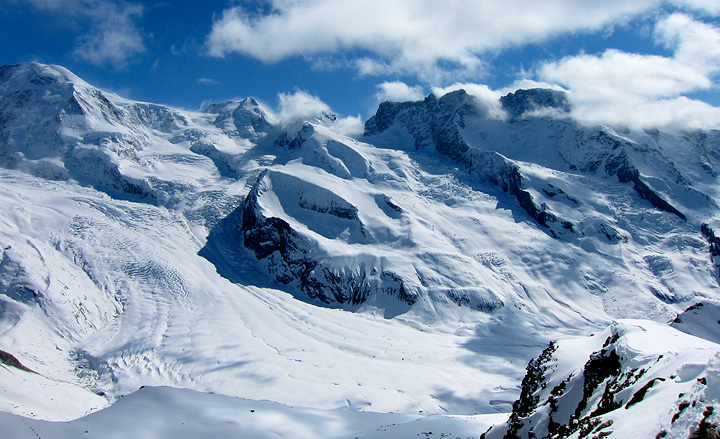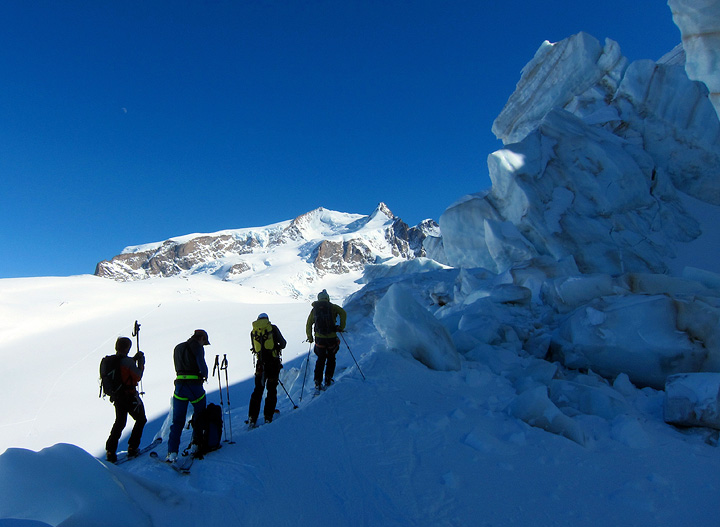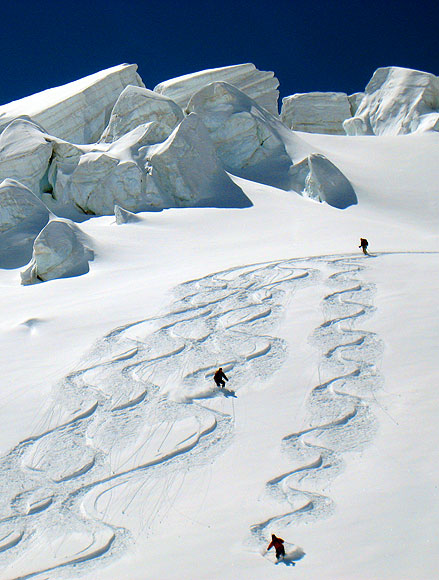 |
|
| Zermatt to Saas Fee, 6-day tour |
| 6 days skiing Maximum
Group Size See also: |
The Alps surrounding Zermatt and Saas Valleys include many of the highest peaks in the Alps. The summit of the Klein Matterhorn, easily reached by cable car from Zermatt (and the starting point of our tour) boasts views of some forty 4000-meter peaks (according to some reports!). With all this high country, there has to be some fine mountain touring. And indeed there is. This 6-day itinerary links together some of the best big descents in the area. It makes a logical connection between the major resorts, and stays in some of the best mountain huts in this part of the Alps. The skiing and climbing on our chosen route is comparable in difficulty to the Chamonix to Zermatt Haute Route. Most days include about 1000 meters in ascent. Or tour up to the Silbersattel, however, includes some 1700 meters up and down!) The descents can be quite long with four of the days offering total descents of over 2000 meters. We have chosen an itinerary that emphasizes the quality of the skiing. Though we do include a couple peak ascents of over 4000 meters, the main goals are to offer spectacular descents, usually north-facing, as we traverse through the Monte Rosa group of peaks and on to the Michabel group.
|
|||||
 |
|
| The Schwarztor. Roll mouse over image to see the route. The Monte Rosa hut is on the left edge. | |
|
Skills
Required |
|
This ski tour requires a high level of fitness and excellent skiing abilities. Most days include over 1000 meters of ascent, with the second having a big 1720 meters up and down. You need to be in good shape. Skiing skills need to be at an advanced to expert level. The reason for this has more to do with the conservation and expenditure of energy over a long day than the absolute technical difficulty of the skiing. There are a few steep sections, but for the most part the slopes are not overly steep. The challenge comes in managing poor snow conditions (heavy wet snow, crud or breakable crust) and not losing too much energy in the process. Great skiers look like they are hardly working, and this is in fact the case. If your skiing is not up to par you will spend far, far more energy than a better skier. There are sections on this tour where we will be skiing slopes of up to about 35 to 40 degrees in steepness. This is quite steep, and usually in this terrain we will be traversing or perhaps side slipping down to easier ground. However, we also need to be able to do turns on these very steep slopes, usually parallel hop turns, or other quick turns where little momentum is generated. On slopes of this steepness, if the snow is firm (as it often is) a fall will most likely result in a slide, and, with hazards such as rocks or crevasses below, such a slide will lead to potentially very serious injury. If you fall on these slopes you will get hurt! Ski skills required;
Skiers who regularly enjoy black or double black runs in most western American ski areas should do fine. If you like to get off the piste and into the crud, ski the trees, and in general look for the steeper shots, you'll probably have a great time on this tour. If you tend to stick to the groomed slopes and find the wild untracked a bit intimidating this is probably not a good tour for you. We will likely encounter all different kinds of snow, from the best to the worst, and you need to have sound energy efficient strategies to cope with them. A good gauge of you ability is found in mogul skiing. If you are good in the bumps and seek them out, then you most likely have developed the rhythm and balance needed for steep or difficult snow. You must be able to ski fairly steep bumps in good conditions, skiing rhythmically and fluidly, following a line near the fall line with good speed control. If you have any doubt about your ability to manage the skiing on this route, please join us in the Alps for a shake-down training session. See our page on Chamonix off-piste skiing. You need to be able to do quick and easy kick turns, facing into the mountain. We can review these skills en route. Previous mountaineering skills are useful, but not required. If you are an expert skier, you will not have difficulty picking up these new skills, as you will already be comfortable on very steep slopes. |
 |
|
| Looking towards Monte Rosa. The Silbersattel is between the two summits. | |
| Zermatt to Saas Fee This itinerary is suitable for advanced/expert skiers in excellent condition. |
|
Day 0 |
We rendezvous in Zermatt in the early evening. Zermatt is easily reached by train in about 4 hours from either Geneva or Zurich. A great idea is to spend a few days on the extensive pistes prior to starting our tour. |
| Day 1 |
We begin by riding the highest cable car in the Alps, to the summit of the Klein Matterhorn. Arriving at the top station, 3820 meters (12,533 feet), we ski across the Breithorn Plateau and into Italy. Crossing under the south side of the massive Breithorn, we pass though the Schwarztor (the "Black Gate") between the Breithorn's East summit and Pollux. Some 1400 meters (4600 feet) of fun north-facing glacier later, we once again put on our skins and continue up to the ultra-modern Monte Rosa hut.
|
Day 2 |
We spend 2 nights in the Monte Rosa hut, one on either side of this day's skiing. Our objective is the Silbersattel, the 4515 meter (14,800 feet) high pass between the Dufourspitz, the highest peak in Switzerland, and nearby Nordend. It is a long ski, both up and down. We spend a second night in the Monte Rosa hut.
|
| Day 3 |
On our third day, we move from the Monte Rosa Group in into the Michabel peaks, the row of high summits that separate the Zermatt and Saas valleys. This is another big day and we'll need an early start. We begin with a long traverse to the north across the lower Monte Rosa Glacier to reach the wide expanse of the upper Gorner Glacier. Easy skinning leads to the Stockhorn pass at 3384. We descend the Findel Glacier and begin the climb up to the Adlerpass at 3789 meters (12,430 feet). The final slope to the pass is fairly steep and often done on foot. If we have enough energy, the summit of the Strahlhorn, at 4196 meter, is not too terribly far away. Either way, we descend the Allalin Glacier, finishing with a short climb up to the Britannia hut.
|
| Day 4 |
On day 4, we'll make an ascent (and, of course, descent) of either the Fluchthorn, 3795 meters (12,459 feet) or, if conditions are good and we didn't do it the day before, the Strahlhorn, 4190 meters, (13,750 feet). The Fluchthorn is, generally fairly straightforward, while the Strahlhorn includes a little bit of booting on the summit ridge. Either way, we have a long descent, down back to the Britannia hut, where we spend a second night.
|
| Day 5 | On our 5th day, we will climb up to the Allalinpass, and then descend to the Täsch hut on the Zermatt side of the Michabel peaks. On the way, we can climb up to the high shoulder of the Rimpfischhorn at over 4000 meters, for a good north-west facing run down the Mellich Glacier.
|
| Day 6 |
Starting day 6 from the Täsch hut, we climb up to the Alphubeljoch, and have a choice of skiing either the readily accessible Feechopf at 3888 meters (12,760 feet), or the steeper and longer Alphubel, a fine 4206 meter (13,800 feet) summit just to the west of Saas Fee. After our climb, we ski down into the Saas ski complex and take the bus, then train, back to Zermatt for our last night. If there is enough snow, it is possible to descend to the west, to Täsch, from the Alphubeljoch between the Alphubel and the Feechopf. This is a long descent, all the way down to wherever the snow runs out. A bit of walking, or possible a short taxi ride will take us to the village of Täsch and then by a short train ride to Zermatt.
|
 |
|
| Skiing down the Findel Glacier from the Cima di Jazzi. Buttery spring corn. | |
 |
Kathy Cosley & Mark Houston AMGA Certified • SNGM members All images, layout and text ©2013 Cosley & Houston Alpine Guides, All Rights Reserved |
|


